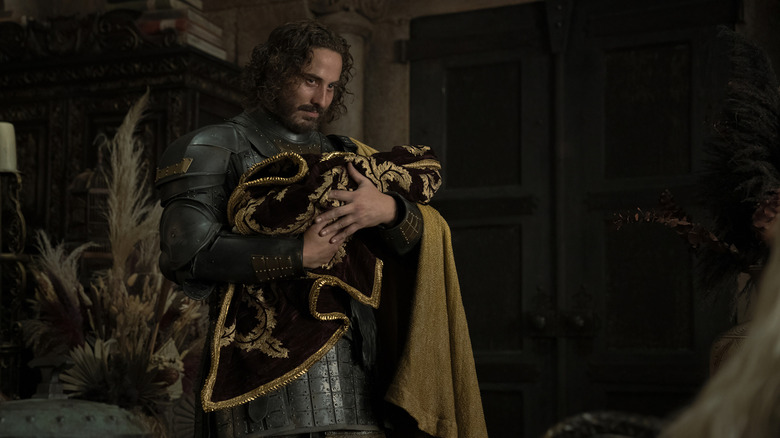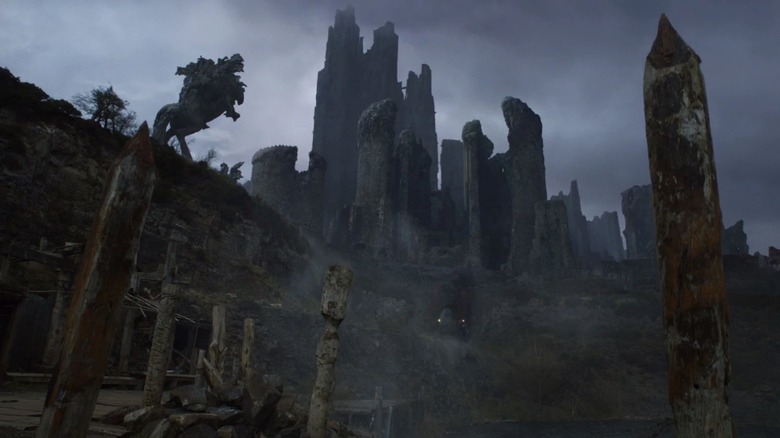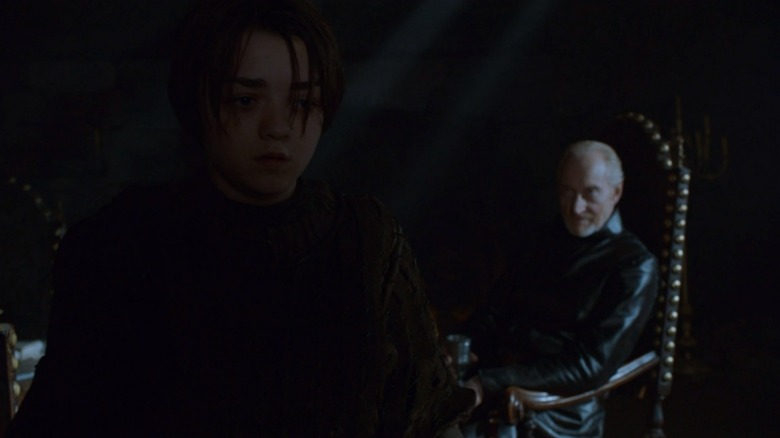House Of The Dragon: The Cursed History Of Harrenhal Explained
This post contains spoilers for the latest episode of House of the Dragon."
Even in a world as sprawling and lived-in as the one featured in "House of the Dragon," we're bound to return to a few key recurring locations that we've seen before (though taking place later in the chronological timeline) during "Game of Thrones." Thus far, the action has largely stayed rooted in the festering political minefield of King's Landing, the capital city that the prequel series has fleshed out much more than we ever saw the first time around. But throughout the course of the series, we've also revisited famous castles and witnessed references to locales such as Dragonstone and even Old Valyria. Perhaps none, however, can quite compare to the legendary and uniquely "cursed" history of Harrenhal.
Episode six of "House of the Dragon" not only hit the fast-forward button to an even greater degree than we've yet seen, throwing us an entire decade in the future, but "The Princess and the Queen" also found time to save its most disturbing moment for a return visit to Harrenhal. The ruined castle lives up to its reputation yet again, as the haunted fortress claimed its latest victims in the form of Hand of the King Lyonel Strong (Gavin Spokes) and his son (and Princess Rhaenyra's not-so-secret lover) Ser Harwin Strong (Ryan Corr) in a devastating fire.
The sinister Larys Strong (Matthew Needham) — Lyonel's younger son and brother to Harwin — is revealed to be the responsible party for such murderous actions, but provides himself plausible deniability by chalking it up as yet another mishap in a long series of such in Harrenhal. Here's everything you need to know about the history of one of Westeros' darkest and most fascinating castles.
Rock beats scissors, but dragonfire beats rock
History is everything in "House of the Dragon" and those who don't learn from it ... well, you know how the saying goes. No location in all of Westeros provides a starker example of this than Harrenhal, which has stood as a lasting reminder to never mess with the Targaryens and their dragons. Built as the largest and mightiest fortress in all the land, King Harren "the Black" named it after himself and made this his home 300 years prior to the events of "Game of Thrones," back when the Seven Kingdoms truly had that many rulers and kings (and more!) all vying for power ... until they were invaded by Aegon Targaryen and his sisters during the era that would become known as the Conquest.
While other lords either died fighting or bent the knee to the unstoppable might of three full-grown dragons, Harren decided to put his trust in the strength of Harrenhal to outlast any attack that Aegon could throw his way. As you can probably imagine, that didn't go so well when Aegon merely mounted Balerion the Black Dread (whose massive skull we've seen in both "House of the Dragon" and "Game of Thrones" before) and literally roasted the defenders within, melting the very castle itself and forever casting a pall over the surrounding area.
Even if that were the last notable instance of Harrenhal popping up in Westorosi history, it would've remained an example for everyone to learn from ... but that was only the beginning of the bad luck attributed to the castle and those unfortunate souls who would dare to take up residence as castellan of Harrenhal.
The history of Harrenhal
When we're first introduced to Harrenhal in season 2 of "Game of Thrones," we see what remains of the castle through the eyes of Arya Stark (Maisie Williams) as she's brought there under captivity of the Lannisters. In one of the more inspired changes from author George R.R. Martin's "A Song of Ice and Fire" series, the writers invented several clever scenes between Arya and the fearsome Tywin Lannister (Charles Dance), the hardened commander who knows the history of such a cursed place ... yet chooses to garrison there anyway. As he explains to Arya, who he takes on as his cupbearer, "Harren the Black thought this castle would be his legacy. The greatest fortress ever built. Tallest towers, the strongest walls ... look at it now. A blasted ruin."
The bad omens didn't end there, however. After Aegon took command of what remained of Harrenhal, each and every one of the houses that were given control of it and its surrounding lands were wiped out at some point or another. Too big and too costly for most families to properly maintain, the ruined castle has directly and indirectly caused the downfall of far too many powerful figures to ignore. It's no surprise that it quickly gained an ill repute that has lasted for centuries afterwards.
In "Game of Thrones," Harrenhal changes hands several times over — from the Northmen to the Lannisters to Petyr "Littlefinger" Baelish (Aiden Gillan) — and practically every one of them met terrible ends. Though those events are yet to come to pass in "House of the Dragon," its reputation has been well-established and the deaths of the most powerful members of House Strong only add another link in the chain of Harrenhal's curse.
"House of the Dragon" airs new episodes on HBO every Sunday night.


